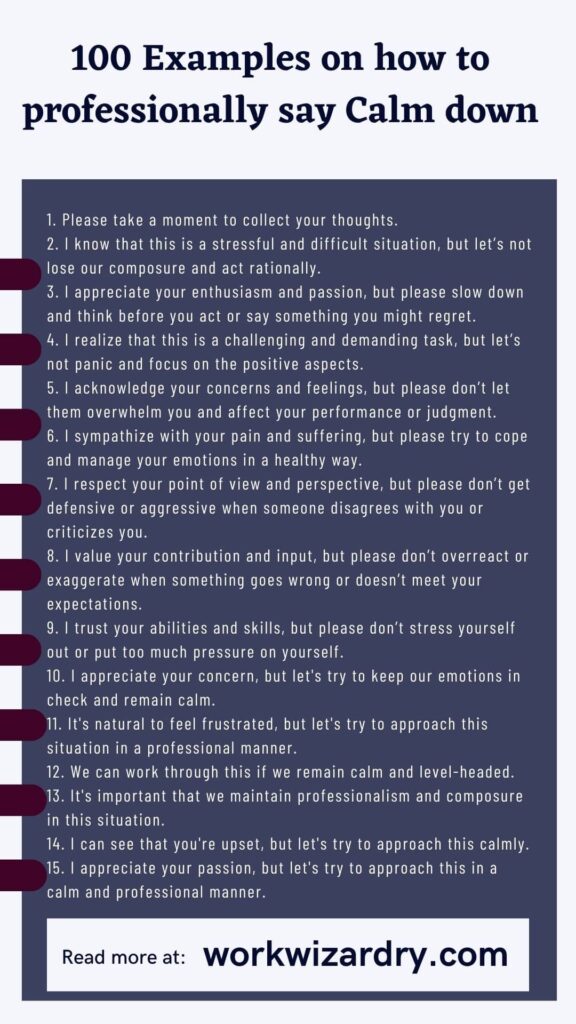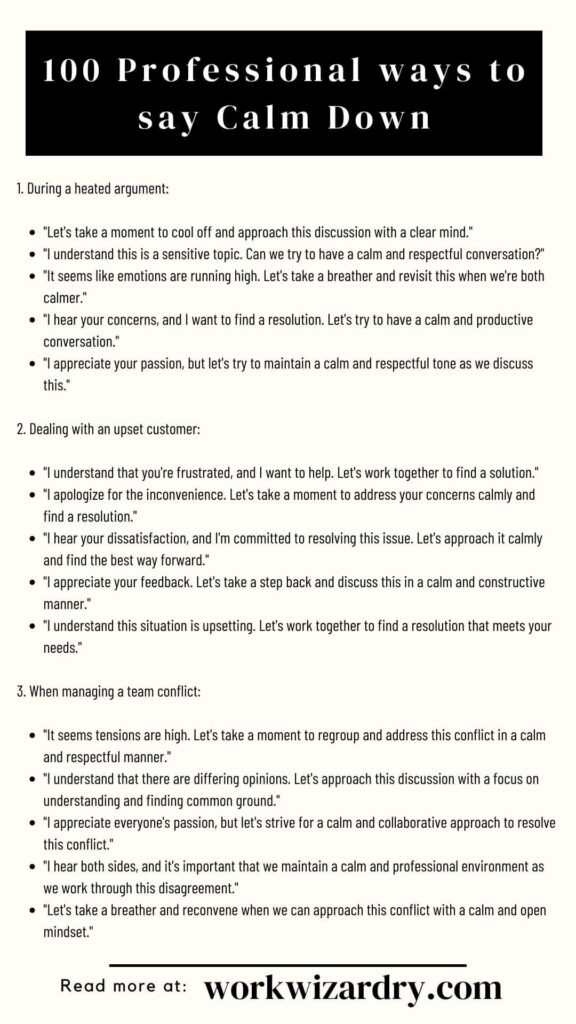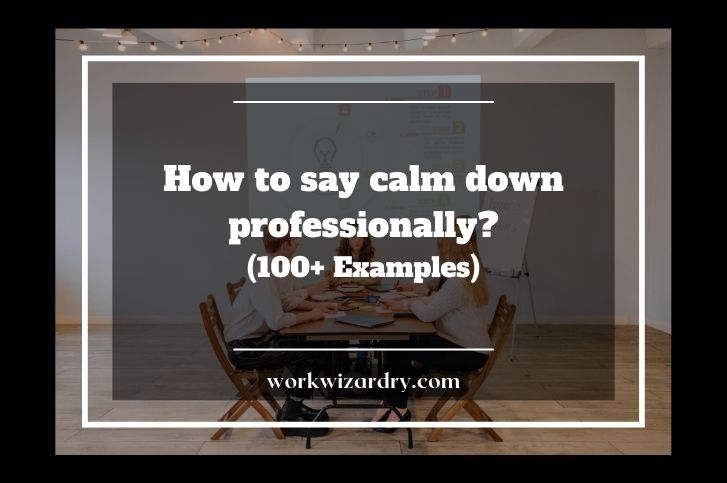In our daily interactions especially during workplace communication, we often encounter situations where emotions run high and tensions escalate.
It’s crucial to handle these moments with professionalism and respect, especially when addressing the need for someone to calm down.
Finding the right words can make a significant difference in de-escalating conflicts and fostering effective communication.
In this blog post, we will explore how to say calm down professionally with practical tips and provide a whopping 100 examples of polite and respectful ways to say “calm down” in various situations.
Whether it’s during arguments, customer interactions, team conflicts, or personal relationships, these strategies will help you navigate challenging conversations with grace and empathy.
Let’s dive in and discover the power of effective communication in diffusing tense situations.
Table of Contents

What to say instead of calm down in a polite way?
When someone is upset or agitated, telling them to “calm down” can often escalate the situation and make them feel invalidated.
It’s important to respond in a polite and respectful manner that acknowledges their emotions and offers support. Instead of saying “calm down,” here are some alternative phrases you can use:
1. Validate their feelings:
Begin by acknowledging their emotions and showing empathy. You can say, “I understand that you’re feeling frustrated/upset/angry right now. but do not lose your composure and act rationally.”
2. Offer support:
Let them know that you’re there to help and listen. Say, “I’m here for you. Is there anything I can do to assist you?”
3. Encourage self-reflection:
Suggest taking a moment to reflect on the situation. You can say, “Maybe it would be helpful to take a deep breath and think about what’s bothering you. I’m here to listen when you’re ready.”
4. Provide reassurance:
Offer words of reassurance to help them feel understood and supported. Say, “I want you to know that I value your feelings and I’m here to support you through this.”
5. Ask open-ended questions:
Engage in a conversation to understand their perspective better. You can ask, “Can you tell me more about what’s bothering you? I want to understand how you’re feeling.”
6. Reflect their concerns:
Show that you are actively listening and understanding their point of view. Repeat back their main concerns or feelings, saying something like, “It sounds like you’re really frustrated about [specific issue].”
7. Offer perspective:
Provide a different perspective or alternative viewpoint that may help them see the situation in a new light. For example, you can say, “Have you considered looking at it from this angle? It might give you a different perspective.”
8. Suggest problem-solving:
Encourage them to focus on finding a solution rather than dwelling on the problem. Say, “Let’s see if we can find a way to address this issue together. What are some possible solutions that come to mind?”
9. Recommend relaxation techniques:
If appropriate, suggest relaxation techniques that can help them calm down and regain composure. For instance, you can say, “Taking a few deep breaths or practicing mindfulness exercises might help you feel more centered.”
10. Express willingness to help:
Reiterate your willingness to assist them in any way you can. Say, “I’m here to support you and find a resolution. Let’s work together to find a solution that works for everyone involved.”
Also read: How Do You Professionally Say Stop Wasting My Time? (50+ Examples)

100+ Professional ways to say calm down
The following is a list of examples on how to say calm down professionally and How to professionally say chill out:
1. Please take a moment to collect your thoughts.
2. I know that this is a stressful and difficult situation, but let’s not lose our composure and act rationally.
3. I appreciate your enthusiasm and passion, but please slow down and think before you act or say something you might regret.
4. I realize that this is a challenging and demanding task, but let’s not panic and focus on the positive aspects.
5. I acknowledge your concerns and feelings, but please don’t let them overwhelm you and affect your performance or judgment.
6. I sympathize with your pain and suffering, but please try to cope and manage your emotions in a healthy way.
7. I respect your point of view and perspective, but please don’t get defensive or aggressive when someone disagrees with you or criticizes you.
8. I value your contribution and input, but please don’t overreact or exaggerate when something goes wrong or doesn’t meet your expectations.
9. I trust your abilities and skills, but please don’t stress yourself out or put too much pressure on yourself.
10. I appreciate your concern, but let’s try to keep our emotions in check and remain calm.
11. It’s natural to feel frustrated, but let’s try to approach this situation in a professional manner.
12. We can work through this if we remain calm and level-headed.
13. It’s important that we maintain professionalism and composure in this situation.
14. I can see that you’re upset, but let’s try to approach this calmly.
15. I appreciate your passion, but let’s try to approach this in a calm and professional manner.
16. “I’m here for you. Let’s talk about what’s going on.”
17. “You’re understandably upset right now, and I totally get why. Let’s see if we can figure out how to solve this together.”
18. “How can I help you right now?”
19. “Let’s take three deep breaths together.”
20. “I understand this is frustrating. Let’s work through it together.”
21. “Take your time, there’s no rush.”
22. “I see that you’re upset, and your feelings are important.”
23. “Let’s take a moment to regroup.”
24. “I can see you’re really passionate about this.”
25. “Would you like some time to collect your thoughts?”
26. “Take your time to process your emotions.”
27. “Let’s find a way to help you feel more at ease.”
28. “Is there anything I can do to support you right now?”
29. “It’s okay to feel [emotion], and I’m here for you.”
30. “Would you like to talk about what’s bothering you?”
31. “Take a deep breath and let’s work through this together.”
32. “I’m here to listen if you want to share what’s on your mind.”
33. “Let’s find a solution that works for both of us.”
34. “I’m sorry if I said something to upset you. How can I make it better?”
Also read: How To Professionally Say Do It Yourself Or Do Your Job? (100 Examples And Tips)

Examples on how to say calm down professionally for different situations
Here are some more examples on how to professionally say calm down or chill down for different situations:
1. During a heated argument:
- “Let’s take a moment to cool off and approach this discussion with a clear mind.”
- “I understand this is a sensitive topic. Can we try to have a calm and respectful conversation?”
- “It seems like emotions are running high. Let’s take a breather and revisit this when we’re both calmer.”
- “I hear your concerns, and I want to find a resolution. Let’s try to have a calm and productive conversation.”
- “I appreciate your passion, but let’s try to maintain a calm and respectful tone as we discuss this.”
2. Dealing with an upset customer:
- “I understand that you’re frustrated, and I want to help. Let’s work together to find a solution.”
- “I apologize for the inconvenience. Let’s take a moment to address your concerns calmly and find a resolution.”
- “I hear your dissatisfaction, and I’m committed to resolving this issue. Let’s approach it calmly and find the best way forward.”
- “I appreciate your feedback. Let’s take a step back and discuss this in a calm and constructive manner.”
- “I understand this situation is upsetting. Let’s work together to find a resolution that meets your needs.”
3. When managing a team conflict:
- “It seems tensions are high. Let’s take a moment to regroup and address this conflict in a calm and respectful manner.”
- “I understand that there are differing opinions. Let’s approach this discussion with a focus on understanding and finding common ground.”
- “I appreciate everyone’s passion, but let’s strive for a calm and collaborative approach to resolve this conflict.”
- “I hear both sides, and it’s important that we maintain a calm and professional environment as we work through this disagreement.”
- “Let’s take a breather and reconvene when we can approach this conflict with a calm and open mindset.”
4. When dealing with a stressed colleague:
- “I can see that you’re under a lot of pressure. Is there anything I can do to support you and help you feel more at ease?”
- “I understand that this situation is causing stress. Let’s take a moment to breathe and approach it with a calm and focused mindset.”
- “I appreciate your dedication, but it’s important to prioritize your well-being. Let’s find ways to manage the stress and work through this calmly.”
- “I hear your concerns, and I want to help alleviate some of the stress. Let’s discuss strategies to approach this situation calmly and effectively.”
- “It’s understandable that you’re feeling overwhelmed. Let’s work together to find a solution while maintaining a calm and balanced approach.”
5. When addressing a panicking individual:
- “I can see that you’re feeling anxious. Let’s take a moment to breathe and approach this situation with a clear mind.”
- “I understand that you’re feeling overwhelmed. Let’s try to stay calm and focus on finding a solution step by step.”
- “I’m here to support you. Let’s take a deep breath and tackle this situation calmly and methodically.”
- “I hear your concerns, and I want to help you through this. Let’s approach it calmly and find a way to address each issue.”
- “It’s natural to feel panicked, but let’s try to stay calm and work together to resolve this situation.”
Conclusion:
Remember, the key is to approach the situation with empathy, respect, and a genuine desire to help.
By using these alternative phrases for calm down, you can effectively communicate and de-escalate tense situations while maintaining a professional and respectful demeanor.




